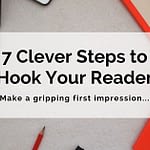Lately, while browsing the internet, an article caught my attention. This is the post from Monica , a young American who is trying to find a place in the publishing world with her first novel.
Generous by nature, the aspiring writer shares on her blog the advice given by Kathryn Johnson, an experienced author at Professional Ghostwriter who has published more than 40 novels (most of them historical ones). Indeed, she holds a writing course on how to captivate the reader.

Monica cites 7 recommendations that I would take care to develop.
Table of Contents
How to capture the attention of your readers?
1. Surprise
First and foremost, your story should stand out from the rest if you want to intrigue the audience. You might as well take care of your concept. It is a commercial argument that can appear in the pitch (summary in one or two sentences of a book, intended to convince in a few words of the interest of a story that we often find in the back cover and which is requested by some editors). It can also be found in the title.
For example, gone with the Wind, His Majesty of the Flies, On the Road, The Stranger, The Little Prince and The Postman Always Rings Twice. All these evoked novels (from bestselling books or at least considered masterpieces of 20th century literature) have in common titles with enormous evocative power .
Concerning the pitches, here are some of them:
Letter from an unknown woman (1922) by Stefan Zweig: A writer receives a letter from an unknown woman: “It is since that second that I loved you. I know women have said this word to you often.”
1984 (1949) by George Orwell: From all the important crossroads, the face with the black mustache stared at you. There is one on the opposite wall. Big brother is watching you.
Flight over a Cuckoo’s Nest (1962) by Ken Kesey: a sane man who rebels against authority is voluntarily committed to a mental hospital to escape prison.
Misery (1987) by Stephen King: a famous writer is kidnapped by one of his completely crazy admirers who asks him to rewrite a book for him.
2. Emotion
Kathryn underlined the essential role of emotion in the appreciation of a work since our brain takes into account what we feel to assess what is important to us. In a work of fiction, this means that your character’s reactions to adversity show the reader what is important to them and allow them to become more attached to the character.
Put your protagonist in a difficult situation and show us how he reacts. What are your character’s fears? Its needs? What do you want your reader to feel?
To make your story universal, it is important to base it on the following points.
- The human emotions: fear, love, hate, envy, etc.
- The deadly sins: wrath, greed, lust, etc.
- The character’s motivation: betrayal, revenge, discovery, rebirth, survival, etc.
- The virtuesand moral dilemmas: loyalty, faith, responsibility, etc.
One of these elements is that which will link us to your protagonist, which will promote our identification and which will help you as an author to deliver us a work that is both original and relevant today.
David Morrell, a Canadian writer and creator of the character of John Rambo, recommends that we work on the point of view of the protagonist and his interpretation, his mental representation of the surrounding world, the gestures of the other characters to evoke the emotion.
3. The protagonist’s objective
We have all heard this advice more or less before, but only because it is important, FUNDAMENTAL. Your character must have a purpose. A plan to achieve it. And we need to know what its purpose is at the beginning of the story.
What does he need to achieve and what does he lose if he does not reach his goal? What are the internal and external obstacles that prevent him from getting what he wants?
One of the best examples is the Prison Break series. In our example, the goal of Michael Scofield (the hero) is to save his brother, Lincoln Burrows, and prove his innocence. The stake: his last resort having just been rejected, the brother has only a few days before him before his execution.
Michael’s plan: Deliberately imprison himself and organize the escape of his death-row brother. His plan that could have been insignificant becomes exciting thanks to the time limit he has to accomplish his goal, not to mention the brotherly bond that unites them, adding a non-negligible dramatic touch.
4. Keep what is interesting and necessary for the reader’s understanding
One of the trickiest exercises for a writer is figuring out exactly what information the reader REALLY needs to ensure their understanding of events without inundating them with the full history of your world (as complex and interesting as it is)
Kathryn thinks that while we think readers need to know everything, in reality they need very little information to want to know what’s next. So, one way to avoid the temptation of information overload is to start the story with the character in the middle of an action or dialogue.
The incipit of L’Amant (1984) by Marguerite Duras is like a sledgehammer:
“One day, I was already old, in the hall of a public place, a man came towards me. He made himself known and he said to me: “I have known you forever. Everybody say you were beautiful when you were young, I came to tell you that for me I find you more beautiful now than when you were young, I liked your young woman’s face less than the one you have now, devastated.”
Une Vie de Guy de Maupassant (1883) begins with “Jeanne having finished her trunks, approached the window, but the rain did not stop”. We don’t know who Jeanne is, or where she is, or where she is going.
You will notice that sometimes, it is better to avoid exhibition scenes, especially when the subject takes a long time to explain, and the characters are numerous. And keep in mind that some information may not be conveyed explicitly, that is, through dialogue, knowledge of the narrator or character impressions, but rather implicitly.
Moreover, a little tip from friend Stephen King for this last point that he deals with not without humor in his book, Ecriture: Mémoires d’un Métier :
5. Living descriptions

Detailed and precise descriptions allow the reader to project themselves into your story which is necessary to keep them alert. Always focus on one or two specific details instead of drowning us with some sort of catalog.
So, avoid giving too many descriptions that are irrelevant or those that come across as “pink cherry blossoms” (we have rarely seen oranges) or “This is a traditional Japanese house.” It has sliding doors”.
Personally, I adore the poetic style of Truman Capote which abounds in original images: “Slipping some sweets in the vinegar of his voice.”, “Miss Sook, sensitive as a hair”, “Tico Feo sang a song as gay as money being stirred”. Moreover, his (striking) way of introducing his characters (in a few words), even those who have a secondary role, commands admiration: “The man who had spoken was small, cut out of barrel, and of a brick complexion; he walked to the threshold of the living room and stumbled to a halt. ”
6. Conflict
As mentioned in the second tip, your characters must face their demons and react. And finally, they have to fix the problem. Guess the central conflict in your story and make sure it’s clear from the start.
In dramaturgy, conflict sustains the plot, it is even its basis. Without conflict, there is no stake; therefore, zero interest for the reader. Conflict is motivated by power: who has it, who desires it and how each will try to get it. From this postulate, a host of possibilities become possible: force, blackmail, seduction, etc.
Ben Bova says:
“The work of the writer is to be a troublemaker! Find as many conflicts and problems for your protagonist and on as many levels as possible, letting a new problem arise from the previous one. And never fix a problem until you’ve created at least two more. It is the unresolved issues that form the chain of promises that keep the reader interested. “
This doesn’t mean that your characters have to be passive. It is not impossible to write a good novel in which the protagonist is entirely the victim of circumstances and events, but it is very difficult, and it is very likely that readers will get irritated to see such a passive main character. And erased. So, why not try to invent a hero who acts on the plot and drives the action?
The favorite character of Philip Pullman, known for the literary cycle at the crossroads of the worlds, is Tintin; he appreciates the balance between his blandness, his lack of depth and at the same time, his temerity, his courage and his curiosity. Yet although he is the archetypal young hero without blemish or temptation, he is not passive; his curiosity and his courage push him to try to unravel all kinds of mysteries and to always defend the weak or to save lives at the risk of his own.
7. Logic
Concentrate on the story, the plot. This is the best way to interest the reader.
Tom Clancy and Mark Twain have said it: fiction must have meaning. There must be a cause and effect relationship in your story. The characters must act according to their personality, their skill and the situation in which they find themselves.
Kathryn used the example of one of her students who was writing a novel with the main character of a “leather man” (office worker) who does nothing but type texts all day. And who suddenly is able to climb a mountain. It just doesn’t make sense, if you look at his skills. Fortunately, the problem was easily fixed by showing, in a previous chapter, that the character was in training. In dramaturgy, this notion is called the notion of “preparation / payment”.
It’s your turn
You have enough tools to capture the attention of your readers.
You now know the importance of a good story. Dan Brown is not a very good writer, yet The Da Vinci Code has sold millions of copies thanks to the sheer strength of its story.
Don’t focus too much on your style, but instead aim to perfect your plot, to make it impactful, while remaining simple, direct, but effective.
Try to apply what you just read in your first chapter and see if the feedback is different.
In any case, good luck!
Also Read:
123Movies Online: Free Alternative Sites
Kakegurui Season 3 Release Details

Be First to Comment